I try to write my posts as unbiased as possible and recommend the products I consider to be useful and the best. I use affiliate links, this means that–at no extra cost to you–I can make a commission on a purchase you make after clicking on them. As an Amazon Associate I earn from qualifying purchases.
German Shepherd Barking:
Curse or Blessing?
Is your German Shepherd barking too much? And yet…do you secretly like that he is keeping the burglars away? Following, I want to share with you tips and techniques that can help you have peace and quiet as well as protection from your German Shepherd dog.
The secret, and I will spill it out now, is to use positive training methods. These are efficient, fun and can be used to raise a dependable and friendly dog that will bark on command if needed.
I have met several German Shepherd dog owners that tell me they want their dog to be friendly with kids, family and friends -but not with strangers. This is a hard concept to understand, specially if you are a dog. Besides, you do NOT want a dog capable of hurting people near kids, family and friends.
That said, it is possible to have a friendly dog that can PRETEND to want to hurt people when told to. I think this is a pretty neat compromise that is also fairly easy to train. Let’s get started!
Stop nuisance German Shepherd barking
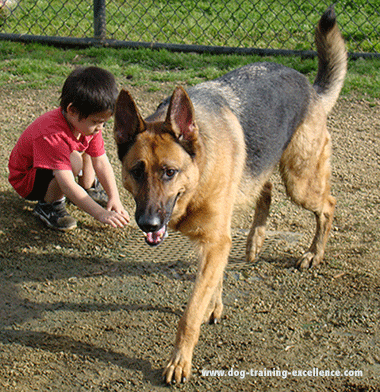
If you found this page, it is entirely possible that your hound already has a barking problem you would like to fix before moving on to teaching him to bark on command. This is an important step because, although many barking problems are mild, some do require special attention.
For example, German Shepherd barking due to anxiety is something that needs to be properly addressed to help the animal relax and be friendly around anyone, specially friends and family. If, after reading this section, you realize your dog has a true aggression problem and barking is just the tip of the iceberg, I highly recommend you find a professional (and positive) dog trainer in your area to help you one-one-one - Search the APDT for one near you.
Step #1: Why is my German Shepherd barking?
You must become a detective and figure out why is your dog barking. Below you will find some of the most common reasons and links to step-by-step tutorials to solve barking in your GSD. Observe your pet carefully, make notes, ask neighbors and family members what they have seen.
Pay attention to what is happening in the environment that triggers barking: what is the body language of your German Shepherd telling you? is there a consequence to barking (someone yells, dog on the other side of the fence walks away, etc)?. This will help you get an accurate diagnosis and choose the right training program.
Step # 2: Use the appropriate training program to stop German Shepherd barking!
The following barking problems should be addressed before formally teaching your dog to bark on command and sometimes this is not recommended at all.
Fearful German Shepherd barking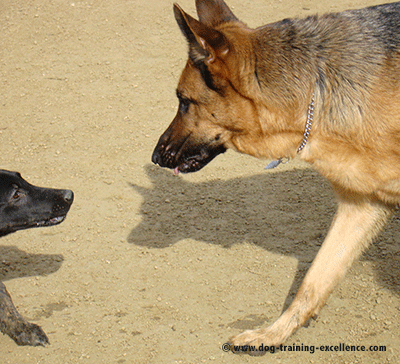 German Shepherd anxiety may first appear as a barking problem. These are dogs that are truly afraid of something and pushing them to face their fears will only make matters worse. The best techniques involve slowly teaching your dog to change the emotion state of fear to one of joy in the presence of the fear trigger. Most fearful dogs will never become completely relaxed, so you will always need to be on the alert and manage the environment to prevent aggression from arising. I highly recommend you do not train a fearful dog to attack or bark on command. This link will help you get started on a training program to diminish your dog’s fears. |
Resource guarding in German Shepherd dogs
Also known as food aggression, resource guarding is a type of fear, in this case it is the fear of loosing something. Common things dogs will guard are toys, furniture, and even the owner. Because this also falls under the “fear” category you must be very vigilant and avoid situations that will make your dog become food aggressive. Follow this link for more information on this issue. Stress and anxiety barking in German Shepherd dogsDogs can become stressed just like we do and high stress levels can trigger excessive barking. This link talks about common stressors and how to get rid of them. 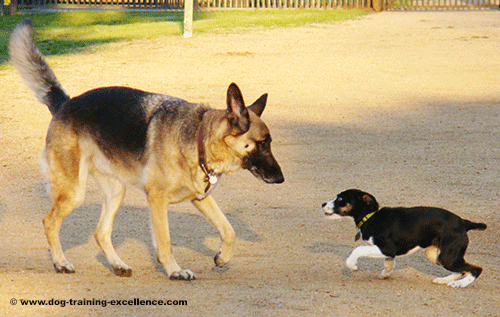 |
The barking problems mentioned below can be addressed at the same time as you teach your dog to bark on command. In fact, you will be using your hounds natural barking to start training it. So, find the category your dog falls into, read the corresponding article and then come back and read the step-by-step guide to teach your dog to bark on command (Step #3). This is important because you will most likely be doing steps #2 and #3 at the same time.
I am so joyful about life I need to bark!Some dogs simply can’t help themselves and have so much energy that barking is the only way they know to express their feelings. These are dogs that may bark at the doorbell, out of excitement when you are trying to put the leash on, or they bark at other dogs to make social contact (rude, but social nonetheless). A good dose of impulse control exercises and providing a different source for energy outlet can go a long way! German Shepherd barking to alert of a possible intruder!
 I left this one for last because although it can become nuisance barking, this is the kind of barking most owners want in their German Shepherd dog. This article explains how to tone it down if it is upsetting you or the neighbors too much! |
German Shepherd barking for attention!
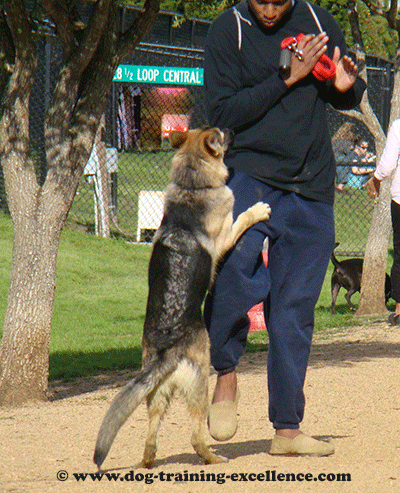 Most dogs like attention, some clever dogs can even train their owners to get it on demand! Bark! bark! bark! and the owner complies. Take away the attention while the dog is barking or teach an incompatible obedience command to solve this problem! Bored German Shepherd barkingYou must understand that German Shepherd dogs were bred to work in the fields all day long every day of the year! If you try to confine such a dog to a house/apartment and do not provide environmental enrichment, exercise and training…chances are your dog will find an outlet:barking! Start entertaining your bored pet with these ideas! |
Step #3: Train your German Shepherd to bark on command!
Use the trigger to make your GSD bark and praise him for doing it ONLY after you say the command, but not if you don’t say it.
Now that you have solved any problematic and excessive German Shepherd barking problem, it is time to teach your dog to do it only when asked to. Practice, patience and consistency will ensure your hound responds reliably.
By now, you must have figured out what makes your dog bark and you will use this to make him speak! The example below is for doorbell barking dogs, but you can adapt the protocol as needed and use the barking trigger that makes your dog talk.
You will need: 1 helper, barking trigger available, treats.
- A person outside will ring the bell when he hears you say “Speak!” (cell phone communication or intercom ON).
- Your dog will most likely bark at the sound of the doorbell!
- It is time to reward your dog! Say your marker word and maybe rub your pooch under his chin, but avoid the use of food treats (we will need them for the quiet part!). Barking is usually fun on itself for dogs, that is why praise is usually enough.
- When you have had enough of the yappity-yap of your dog say “Quiet!” and immediately show (only show) your pooch the food in your hand, place it right under his nose so he can smell it, which will make him become quiet.
- As soon as he is quiet use your marker word for praise and then give him the treat. You are using the training method capturing for both commands.
- Repetition is what helps your dog understand what you are asking of him. Repeat the above steps 10-20 times for a few days. To prolong the “quiet” time, start delaying the treat gradually. It's kind of like training "stay", but with shush instead.
- You know your GSD has learned the “Speak/Bark” cue when he starts barking after your cue and BEFORE the sound of the doorbell. To test it, ask your helper to ring the bell with a few seconds of delay (to give the dog time to process and respond to your voice command instead). If he doesn’t bark, just repeat a few more times the above steps. Your GSD understands the command when he barks after you say it but before the doorbell sound (or whatever trigger appears).
- For a command to be reliable, you must also practice it without the trigger and in many different situations: different times of the day, different places, with different people approaching, different background noises, etc. The idea is to help him understand under which circumstances it is OK to bark and when it is not. Be consistent: always ask him to bark when someone walks through the lawn, and always ask him to quiet if someone simply walks on the sidewalk.
To end, I would like to say that barking collars are not recommended. They come with built-in problems and might even make matters worse. If you are set on using a barking collar, please follow this important advice.
Hope this guide helps, join us on Facebook for questions, story sharing and laughs!
Home > Training German Shepherd Dogs > German Shepherd Barking
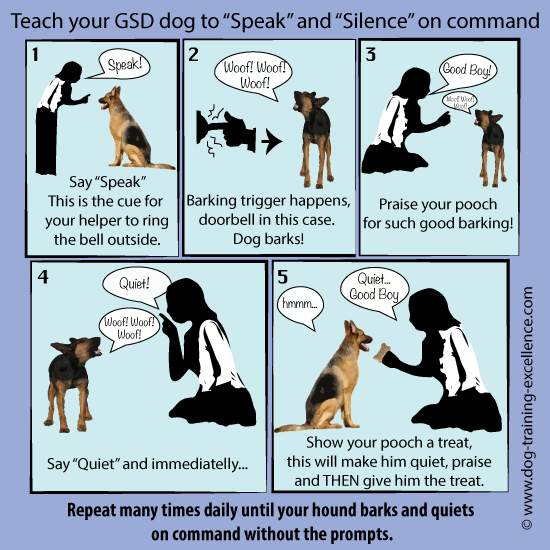

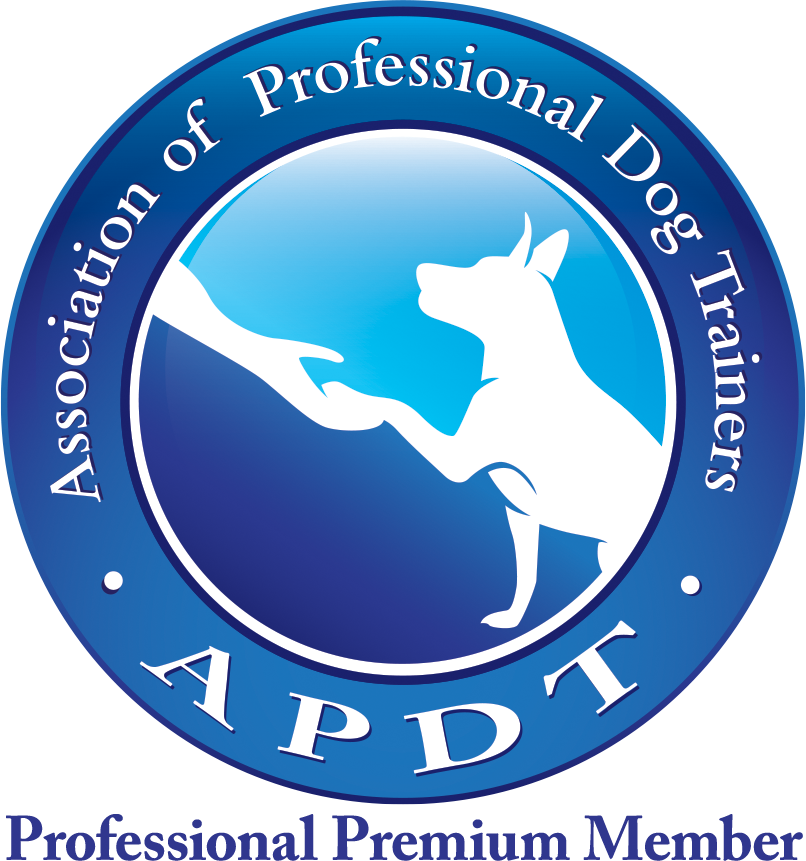


New! Comments
Questions? Anecdotes? Tips? Leave me a comment in the box below.